Straps, Bandages and Tapes
Wrinkles, sagging necks and double chins, characteristics of many women over the age of thirty-five, were commonly treated by early beauty culturists by combining massage and skin-care products with straps, bandages and/or tapes.
Straps
In salon treatments, strapping was usually an extra in a regular salon facial. Clients could ask for it specifically or would be tactfully informed that it was needed. For many woman over the age of thirty-five, a strapping treatment would have been considered mandatory but they were also recommended to younger women as a preventative. Clients were also encouraged to buy their own straps to continue the treatment at home; wearing them while sleeping at night or at some other time of the day in private.
A wide variety of straps were available in the past covering all areas of the face and neck.
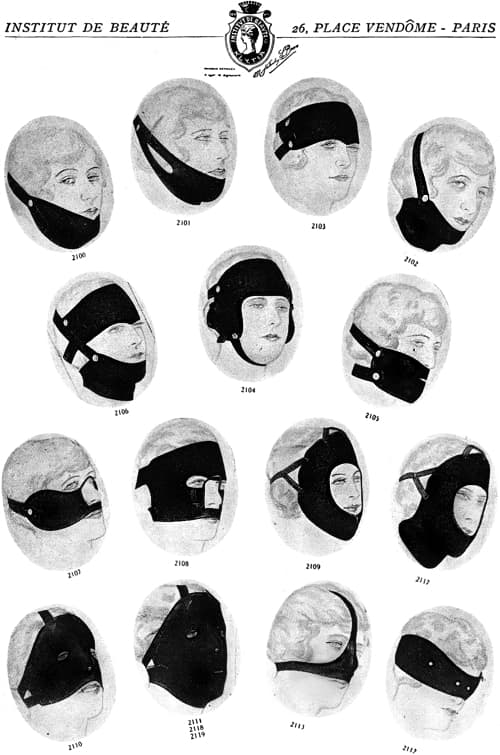
Above: 1928 Straps sold by the Institut de Beauté Klytia (Paris).
The two most common forms of straps were chin straps, used to lift sagging neck muscles and reduce double chins, and forehead straps, worn to smooth out wrinkles above and between the eyebrows.
Chin straps
Facial treatments using chin straps, sometimes referred to as ‘tie-ups’, were presumed to ‘restore muscle contractility and aid in the breaking down of accumulated fat cells’, so were recommended for mature women with flabby facial muscles, saggy throats and/or double chins.
Chin straps were commonly used with skin foods and/or astringents and were generally combined with some form of muscle stimulation to ‘improve circulation and tone muscles’. This might involve a facial massage before or after the strap was applied and/or tapping the skin with the fingers (tapotement) or a patter.
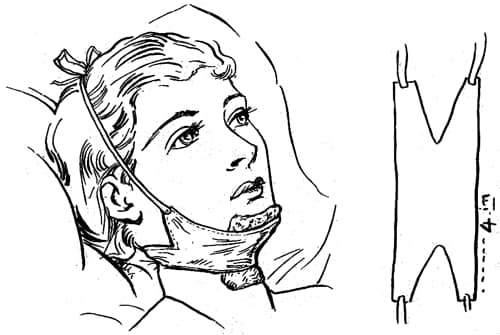
Above: An oiled silk chin strap holding a cotton wool pad, dampened with astringent or stimulating camphorated oil (Verni, 1946).
See also: Patters
In some salons a more forceful massage routine, known as muscle strapping, was used. Also known as muscle lifting, muscle toning or face-moulding (Wall, 1946, p. 549), it used more pressure than a normal massage and concentrated on those areas of the face and neck where lines had already appeared or might arise in the future.
See also: Massage, Wrinkles and Double Chins
Better-equipped salons may have used electricity to stimulate the circulation with vibratory massage (vibro massage), high frequency or electrical muscle contraction machines. These treatments were presumed to tone muscles, remove fatty deposits and/or improve circulation.
During the facial, the chin strap held the lower part of the face and neck in the proper position. After applying the strap the operator would go over the chin and neck, patting and smoothing the skin. Ice and astringents were commonly combined with the strap to ‘restore the vitality of flaccid muscles so that they would lift and improve the contour’ of the face. Skin foods were also applied to ‘rebuild impoverished tissues, thereby strengthening and firming the flaccid, sagging muscles of the face’.
See also: Skin Foods and Skin Tonics, Astringents and Toners
Forehead straps
Forehead straps were employed to remove or diminish frowning lines and wrinkles. Before the strap was applied, the skin would be treated with a skin food and, if considered necessary, muscle oils would be patted in over the deeper lines like those between the eyebrows.
See also: Muscle oils
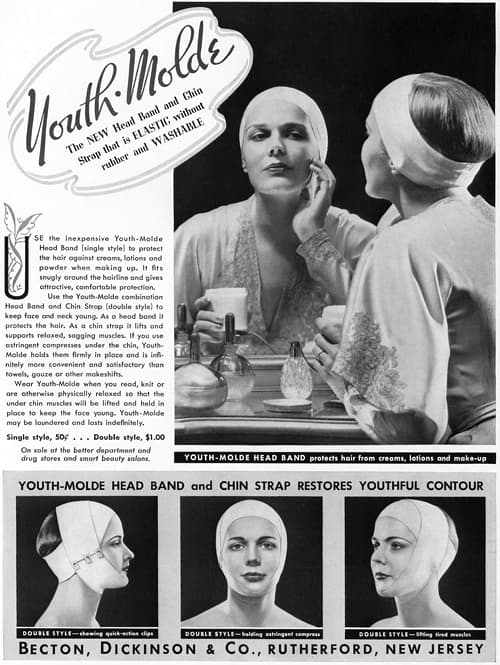
Above: 1935 Youth-Molde.
Towels and bandages
Salons that did not have the resources to make and use ready-made straps could achieve similar effect by using surgical bandage or a small towel. These would be tied or wound around the chin and/or forehead. Towels were generally used dry, whereas bandages were sometimes applied wet. Small towels were also used by women who wanted to do a ‘tie-up’ at home, something regularly suggested by beauty writers providing advice though newspapers or magazines.
If you want to keep your chin and throat pretty—keep your chin up.
A chin strap will help you get sagging muscles working correctly. It’s of most use when applied expertly, and when you massage and exercise too.
You might ask the operator who gives you a facial treatment to complete it with a “tie-up.” The operator first thoroughly cleanses you face and neck, massaging with a good emollient cream. Then she adjusts the chin strap.
The same routine should be followed at home. Good ready-made chin-straps are cut on the bias, or are made of elastic material. A towel folded diagonally to make a three or four-inch band is effective if used correctly. The bandage should hold the tissues smooth and flat, should not distort the face. Let it just be comfortably snug.(Chin Strap Aids Beauty newspaper article, 1942)
Some notable promoters
Straps were widely used in beauty salons in North America, Britain and Europe but two figures stand out for special mention: Eleanor Adair and Elizabeth Arden.
Eleanor Adair: Although many of her contemporaries – such as Frances Hemming (Cyclax) and Marie Earle – also employed them, no one promoted the use of straps in facial treatments to the same extent as Adair. In 1902, she was granted two British Patents, the first for a forehead strap, the second for a chin strap. Pictures of models wearing forehead and chin straps figured prominently in her advertising and she was reputed to have a wax head wearing straps at the entrance to her salons.
Adair’s ‘Strapping Electrical Treatment’ combined straps, manual work and electrical treatments with Ganesh preparations such as Eastern Muscle Oil, Diable Skin Tonic and Eastern Skin Food. Adair used chin straps to ‘remove double chins and restore lost contours’ while forehead straps were used to reduce ‘deep lines between brows, corners of eyes and over the forehead’. Adair also sold a Domino Strap to help ‘cure puffiness under the eyes’ and Ganesh Wrinkle Plasters for the expression lines around the eyes and mouth.
See also: Eleanor Adair
Elizabeth Arden: Arden was introduced to straps when she worked as a treatment girl in Eleanor Adair’s New York salon and continued to use straps when she started out on her own. Like Adair, Arden used a ‘strapped’ head prominently in her early advertising. Given Arden’s prominence in the beauty industry she helped maintain their use in salons for over half a century; for example, Dorothy Gray’s use of straps came about because she had once worked for Arden.
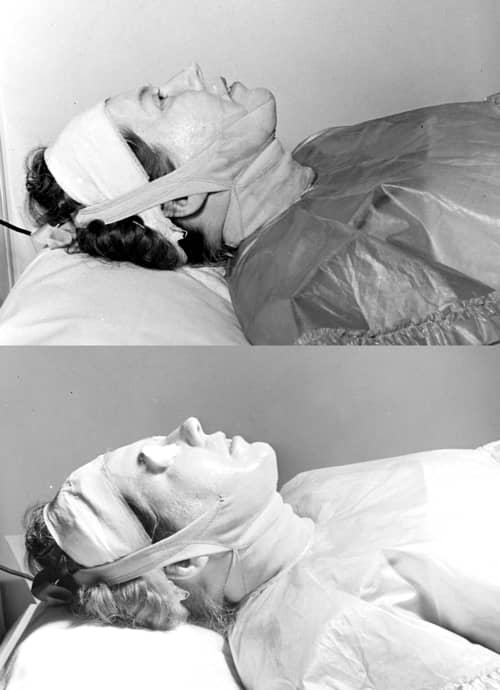
Above: 1950s Dorothy Gray Salon Strapping Treatment. The top photograph clearly shows product underneath the chin strap. The bottom photograph suggests red light may have been included in the treatment. Red light was recommended for dry, rough or wrinkled skin.
See also: Red Light, Blue Light and Dorothy Gray
As well as chin and forehead straps Arden also sold a Puffy-Eye Strap for ‘hollow or sunken eyes’ and an L-Bow Strap; to ‘soften and whiten the elbows’.
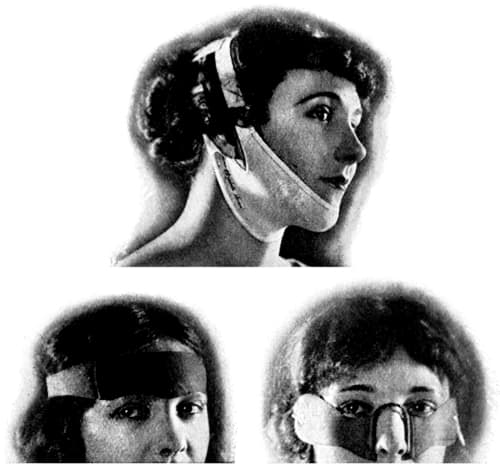
Above: Elizabeth Arden. Top: Chin Strap de Luxe. Bottom: Forehead Strap and Puffy-Eye Strap.
As with Adair, Arden also applied her chin and forehead straps with skin foods, muscle oils and astringents, which in her case meant, Venetian Orange Skin Food, Venetian Muscle Oil and Venetian Special Astringent. Muscle stimulation was intensified through the use of the Arden Patter.
There is no appliance so important to the beauty of woman as a perfectly made Chin Strap. Its use is absolutely essential to every woman past thirty, or after illness, strain or worry. It is beautifully made of flesh colored satin of the very finest quality, and it has an interlining of powerful astringent herbs which aid in invigorating and restoring relaxed muscles. This Strap is a combination chin and neck strap, tailored to fit the cheeks and chin and to round out ugly irregular lines on the throat. It holds every muscle of the lower part of the face and neck in proper position. It should be tightly adjusted and worn each day for fifteen minutes or longer if convenient. It is the daily treatment that counts. If you wish to wear the Strap during the night, you will find it very soft and comfortable as it is a rest to tired muscles. Then do not adjust it as tightly as during the day.
(Elizabeth Arden, n.d., p. 33.)
See also: Elizabeth Arden
Tapes
Tapes were used to correct or delay the appearance of expression lines between the eyebrows and the corners of the eyes or mouth.
Did you ever go to see a lady, not of uncertain but of uneasy age, and find yourself ushered into the family sitting-room by a new servant, who did not know the ways of the house? Did you find her with a court-plaster lozenge an inch wide between her eyes, and one at the outer ends of her eyebrows? At sight of this remarkable ornament, did concern express itself lest she had fallen down stairs, or had a difference with the cat? Were these insinuations parried with veteran resources, and were you dissuaded from further inquiry by the delicate remark that she could interest you better than by giving the history of her scratches? Of course you knew there was a mystery about those bits of court-plaster, and perhaps feel so to this day, unless Nature have given you the mind of a detective. If so, your patience is to be rewarded. The secret of those patches was not scratches, but wrinkles.
(The ugly girl papers, 1874, pp. 212-213)
Taping was widely promoted but not everyone was convinced that they had any effect.
It has been supposed that when once the skin has been thus corrugated into folds, it were possible, by stretching it with adhesive strips, to restore it to its natural evenness and smoothness. This has failed in every instance we have known it tried, and we consider it time [they were] thrown away.
(Brinton & Napheys, 1870, p. 254)
A number of different companies produced commercial versions. For example, the B. & P. Company sold ‘Wrinkle Eradicators’ and ‘Frowners’ through drug and department stores from 1899. The Wings Products Co. – organised by Mrs. Mary Roebling in 1937 – sold Hollywood Wings – medicated pink tabs shaped like wings – for use on facial frowns and wrinkles. They were still being sold in the 1950s. Similar products are still sold today.
See also: Expression Lines
Current usage
You can still buy straps and tapes that promise results similar to those put forward in the 1900s but neither are commonly used in the beauty industry today their place in salon treatments taken over by face masques. These come in a wide variety of forms, can be customised to an individual client’s requirements, and have the added advantage of not needing a laundry service.
First Posted: 22nd October 2011
Last Update: 31st August 2021
Sources
Ayer, H. H. (1892). My lady’s dressing room adapted from the French of the Baronne Staffe. New York: Cassell Publishing Company.
Banford Academy of Hair and Beauty Culture. (1938). Theory and practice of scientific facial culture and muscle strapping. New York: Beauty Laboratories, Inc.
Brinton, D. G., & Napheys, G. H. (1870). Personal beauty: How to cultivate and preserve it in accordance with the laws of health. Springfield, Mass: W. J. Holland.
Elizabeth Arden Ltd. (n.d.). The quest for the beautiful. New York: Author.
Verni, M. (1946). Modern beauty culture (2nd ed.). London: New Era Publishing.
Wall, F. E. (1946). The principles and practice of beauty culture (2nd ed.). New York: Keystone Publications.
Wall, F. E. (1961). The principles and practice of beauty culture (4th ed.). New York: Keystone Publications.
W. M. Meyer Co. (1936). The cosmetiste: A textbook on cosmetology with special reference to the employment of electricity in the care of the hair, scalp, face, and hands, also permanent waving and hair curling. Chicago, Ill: Author.
The ugly girl papers; or hints on the toilet. (1874). New York: Harper & Brothers.
Woodhead, L. (2003). War paint: Miss Elizabeth Arden and Madame Helena Rubinstein. Their lives, their times, their rivalry. London: Virago.
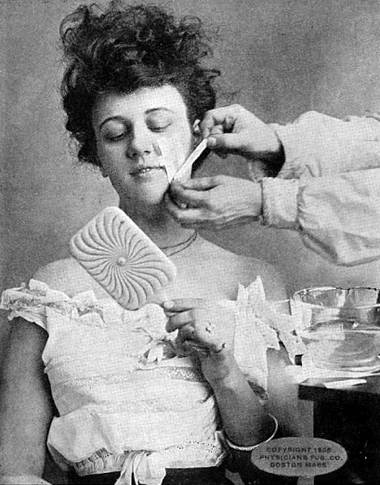
1905 Plaster tape treatment for wrinkles.
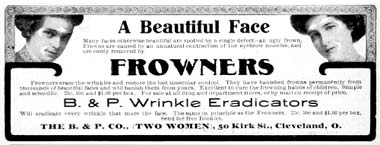
1905 B. & P. Frowners and Wrinkle Eradicators.
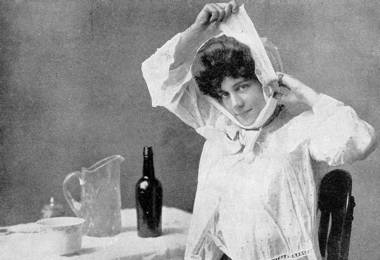
1908 Vinegar astringent bandage.
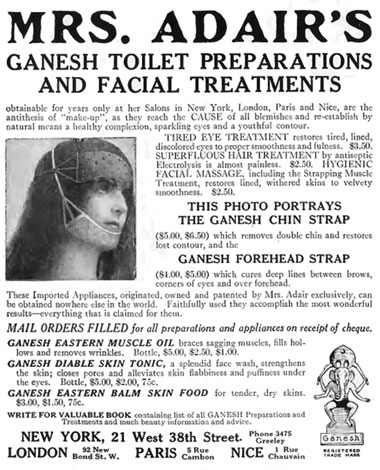
1912 Eleanor Adair Chin and Forehead Straps.
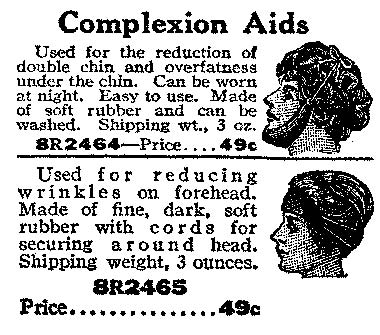
1919 Straps available through Sears and Roebuck.
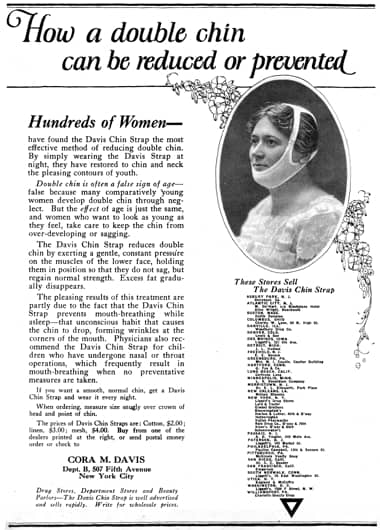
1922 Cora M. Davis.
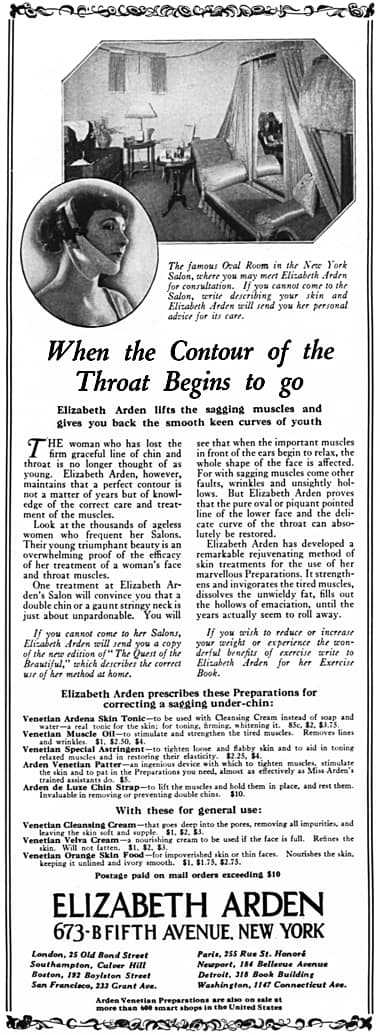
1923 Elizabeth Arden.
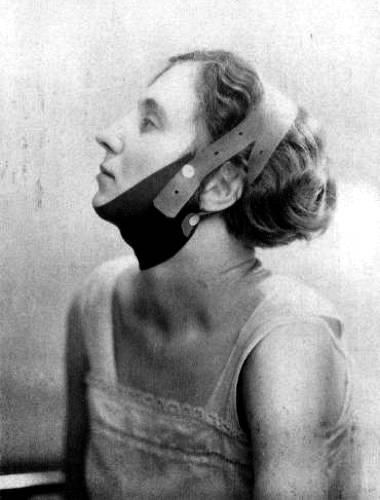
1924 Rubber Chin Strap with adjustable head band.
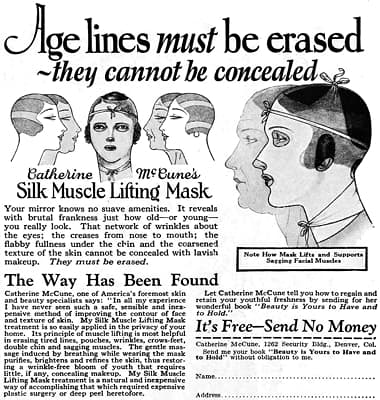
1928 Katherine McCune Silk Muscle Lifting Mask.
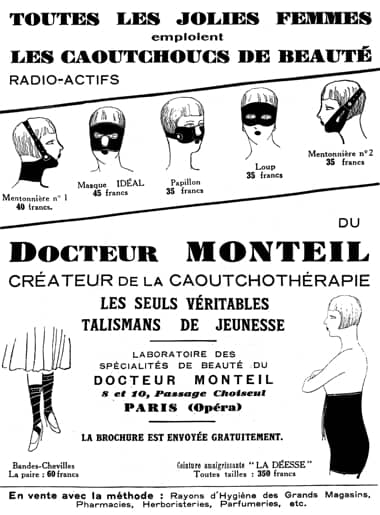
1929 Dr. Monteil straps. These were radioactive.
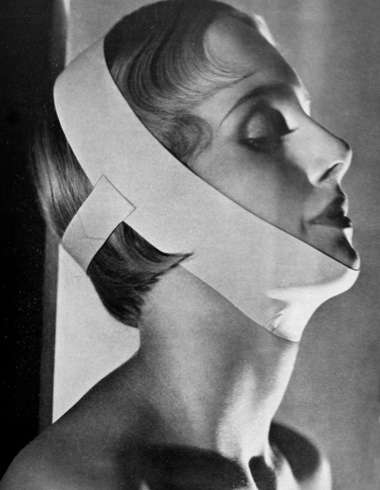
1932 Silvia Ironside Reducing Chin Strap. This rubber strap was not worn over creams and lotions.
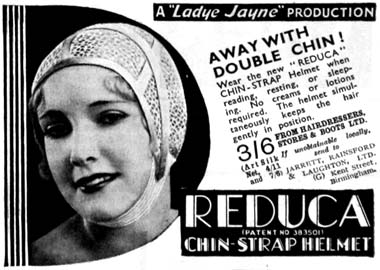
1934 Reduca Chin Strap Helmet (Britain).
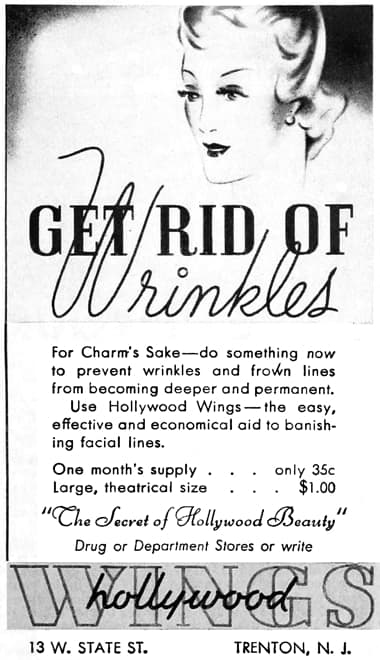
1937 Hollywood Wings.
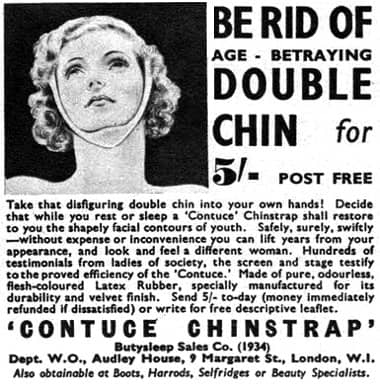
1937 Contuce Chin Strap.
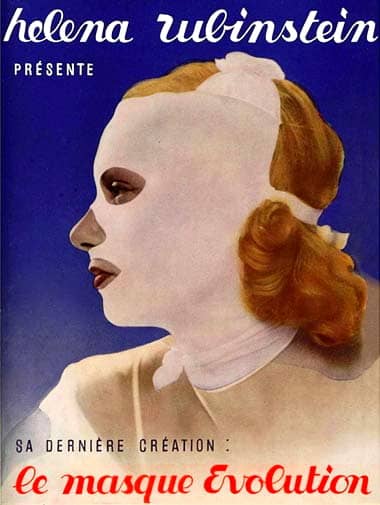
1937 Helena Rubinstein Beautilift Masque made from pink silk dipped in Beautilift Lotion.
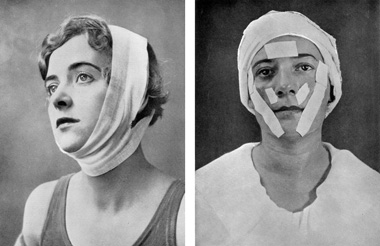
1946 Maria Verni strap and tape treatments.
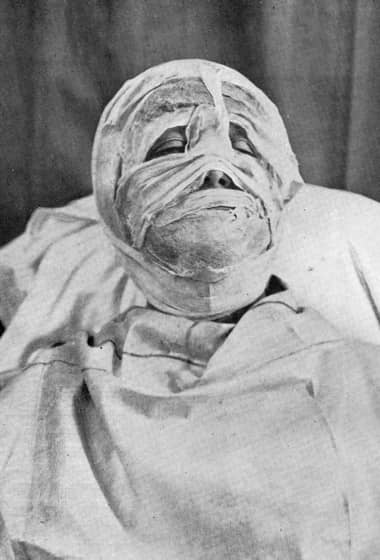
1946 Maria Verni oatmeal pack treatment bound on the face with strips of butter muslin with extra pressure applied to the throat with a chin strap.
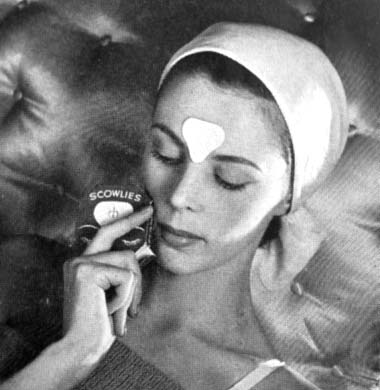
1950 Scowlies from Maria Hornes (Britain).
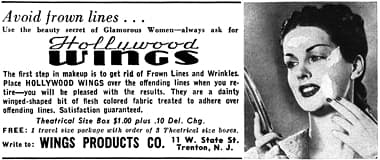
1954 Hollywood Wings.
